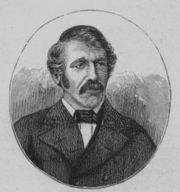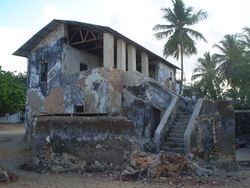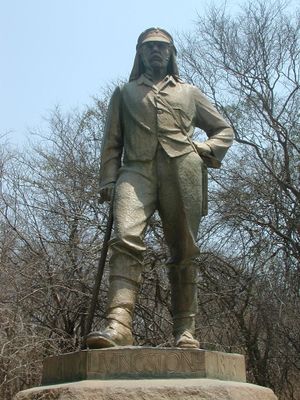ديفيد ليفينغستون
David Livingstone | |
|---|---|
 | |
| وُلِدَ | 19 مارس 1813 Blantyre, South Lanarkshire, Scotland |
| توفي | 1 مايو 1873 (aged 60) near Lake Bangweulu, زامبيا |
| سبب الوفاة | ملاريا & نزيف داخلي بسبب الزحار |
| المثوى | The Collegiate Church of St Peter at Westminster 51°29′58″N 0°07′39″W / 51.499444°N 0.1275°W |
| القومية | اسكتلندي |
| عـُرِف بـ | استكشاف وسط أفريقيا |
| العنوان | Dr. Livingstone |
| الديانة | Congregationalist |
ديڤيد لڤنگستون (19 مارس 1813 - 1 مايو 1873) (David Livingstone) كان مستكشفاً إسكتلندياً لوسط أفريقيا. كان أول أوروبي يرى شلالات فيكتوريا، وهو الذي أطلق عليها هذا الاسم.
ولد ديفيد لڤنگستون في 19 مارس 1813، في مدينة بلانتاير بإسكتلندا. يعرف ليفينغستون بلقائه المشهور مع هنري مورتن ستانلي. كان من أشهر المبشرين المسيحيين في أفريقيا. قرر أولاً أن يكون مبشراً طبياً في الصين، ولكن حروب الأفيون جعلت الصين مكاناً سيئاً بالنسبة للغربيين ذوي النوايا الحسنة. ذهب ليفينغستون إلى أفريقيا بدلاً من ذلك، وبعد أربعة أشهر من السفر، وصل إلى كيب تاون، التي تقع الآن في جنوب أفريقيا، وذلك عام 1841. عامل ليفينگستون الأفريقيين بإحترام. وتعلم لغاتهم وعاداتهم ثم استكشف جزء كبير من القارة. اعتقد لڤنگستون بأن أفضل طريقة لمشاركة الأفريقيين إيمانه هي أن يعلمهم عن العالم الخارجي. دعم لڤنگستون عمله التبشيري عن طريق تأليف الكتب حول سفراته.
لڤنگستون فتح هذه المناطق أمام البعثات التنصيرية، فعلى الرغم من ذيوع شهرته كمكتشف للقارة الافريقية، وقد أمد الاوروبيين بمعلومات جغرافية واثنوجرافية وطبية الا أنه ظل متعصبا للتنصير حتى آخر يوم في حياته.
ولفنجستون اسكتلندي الأصل انضم الى جمعية لندن التنصيرية عام 1838 وعمل في جامعة جلاسجو، وتدرب على أعمال الزراعة والصناعة والتجارة ليقوم بنشاطه التنصيرية ، ولكنه ترجاع وفضل العمل في أفريقيا. وذلك بسبب اضطراب أحوال الصين بسبب حرب الافيون.
وترجع أهمية وخطورة اكتشافات لفنجستون أنه فتح الباب أمام البعثات التنصيري البريطانية ، فبعد أن كان مركز التنصير الرئيسي في كورومان في جنوب أفريقيا، أصبح هناك العديد من المراكز في داخل القارة، فقد توغل لفنجستون في مناطق لم يصل اليها اوروبي من قبل، وقد ساعده في عمله الكشفي والتنصيري اتصاله بالمنصر البريطاني الدكتور روبرت موفات الذي عمل في جنوب أفريقيا وتزوج من ابنته وتوثقت الصلات بينهما بدرجة كبيرة، قام لفنجستون بثلاث رحلات الى أفريقيا، بدأت الأولى 1841 – 1859 واتخذ من كورومان مركز للانطلاق والتوغل داخل القارة، ثم عبر صحراء كلهاري ونجح في الوصول الى أراضي الباروتسي (في روديسيا الشمالية) وتتبع مجرى نهر الزمبيزي حتى مصبه مكتشفا المساقط المائية التي تعترض مجرى النهر وأطلق عليها شلالات فيكتوريا نسبة الى ملكة بريطانيا (2). أما الرحلة الثانية 1858 0 1864 فقد استأنفت فيها اكتشاف مجرى نهر الزمبيزي ووصل الى نهر شيريه أحد فروعه ثم وصل الى بحيرة نياسا.
نهر النيل
أما رحلته الثالثة 1866 – 1873 تلك الرحلة التي كلفته بها الجمعية الجغرافية الملكية في لندن فقد كان الهدف منها فض لغز شبكة الأنهار في وسط أفريقيا والتأكد من الأنهار والبحيرات فيها وتأكيد اكتشافات غيره من المكتشفين.
كان ليڤنگستون رجلاً متديناً بشكل كبير، ولم تعجبه طريقة معاملة المستعمرين الهولنديين والبرتغاليين للشعوب الأفريقية. كتاباته أخبرت العالم عن تجارة العبيد.
In January 1866, Livingstone returned to Africa, this time to Zanzibar, from where he set out to seek the source of the Nile. Richard Francis Burton, John Hanning Speke and Samuel Baker had (although there was still serious debate on the matter) identified either Lake Albert or Lake Victoria as the source (which was partially correct, as the Nile "bubbles from the ground high in the mountains of Burundi halfway between Lake Tanganyika and Lake Victoria" [1]). Livingstone believed the source was further south and assembled a team of freed slaves, Comoros Islanders, twelve Sepoys and two servants, Chuma and Susi, from his previous expedition to find it.
Setting out from the mouth of the Ruvuma river Livingstone's assistants began deserting him. The Comoros Islanders had returned to Zanzibar and informed authorities that Livingstone had died. He reached Lake Malawi on 6 August, by which time most of his supplies, including all his medicines, had been stolen. Livingstone then traveled through swamps in the direction of Lake Tanganyika. With his health declining he sent a message to Zanzibar requesting supplies be sent to Ujiji and he then headed west. Forced by ill health to travel with slave traders he arrived at Lake Mweru on 8 November 1867 and continued on, traveling south to become the first European to see Lake Bangweulu. Finding the Lualaba River, Livingstone decided it was the "real" Nile, but in fact it flows to the Upper Congo Lake.
In March 1869 Livingstone, suffering from pneumonia, arrived in Ujiji to find his supplies stolen. Coming down with Cholera and Tropical ulcers on his feet he was again forced to rely on slave traders to get him as far as Bambara where he was caught by the wet season. With no supplies, Livingstone had to eat his meals in a roped off open enclosure for the entertainment of the natives in return for food.[2] Following the end of the wet season he returned to Ujiji arriving on 23 October 1871.
المرض والألم والوفاة
توفي ليفينجستون في 1 مايو 1873، في بحيرة بانگويولو بزامبيا. معظم جسده أعيد بعد ذلك إلى إنگلترة، ولكن أصدقاء ليفينغستون دفنوا قلبه في أفريقيا.
مراجع
انظر أيضاً
- David Livingstone Centre (museum in Blantyre, Lanarkshire, Scotland)
- Thomas Baines
- John Kirk
- Livingstone Inland Mission
- The Historical Background to Church Activities in Zambia
الهامش
مصادر أخرى
- Butcher, Tim (2007). Blood River:A Journey To Africa's Broken Heart. London : Chatto & Windus. ISBN 0-7011-7981-3
- Eynikel, Hilde (2005). Mrs. Livingstone: een biografie. Leuven: Davidsfonds. ISBN 90-5826-347-9 (هولندية)
- Holmes, Timothy (1993). Journey to Livingstone: Exploration of an Imperial Myth. Edinburgh: Canongate Press. ISBN 978-0-86241-402-3
- Jeal, Tim (1973). Livingstone. London: Heinemann. pp. 427p. ISBN 0-434-37208-0.
- Livingstone, David (1905) [1857]. Journeys in South Africa, or Travels and Researches in South Africa. London: The Amalgamated Press Ltd.
- Livingstone, David and James I. Macnair (ed.) (1954). Livingstone's Travels. London: J.M. Dent.
- Livingstone, David (1999) [1875]. Dernier Journal. Paris: Arléa. ISBN 2-86959-215-9 (بالفرنسية)
- Martelli, George (1970). Livingstone's River: A History of the Zambezi Expedition, 1858-1864. London: Chatto & Windus. ISBN 978-0-7011-1527-2
- Morrill, Leslie, and Madge Haines (1959). Livingstone, Trail Blazer for God. Mountain View: Pacific Press Publication Association.
- Philip, M. NourbeSe (1991). Looking for Livingstone: An Odyssey of Silence. Stratford: The Mercury Press. ISBN 978-0-920544-88-4
- Ross, Andrew C. (2002). David Livingstone: Mission and Empire. London and New York: Hambledon and London. ISBN 978-1-85285-285-6
- Waters, John (1996). David Livingstone: Trail Blazer. Leicester: Inter-Varsity. ISBN 978-0-85111-170-4
- Wisnicki, Adrian S. (2009). "Interstitial Cartographer: David Livingstone and the Invention of South Central Africa". Victorian Literature and Culture 37.1 (Mar.): 255-71.
وصلات خارجية
- Livingstone Online - Explore the medical writings of David Livingstone The leading internet site for David Livingstone's writings and the only site to offer images of original documents alongside transcribed, critically edited versions
- Stanley and Livingstone Original reports from The Times
- Works by or about David Livingstone at Internet Archive (scanned books original editions color illustrated)
- أعمال من David Livingstone في مشروع گوتنبرگ (plain text and HTML)
- A Brief Biography of David Livingstone
- The Life of David Livingstone
- David Livingstone biographies
- Livingstone Tower at University of Strahclyde
- Dr. Livingston (obituary, Wed., Jan. 28, 1874) in "Eminent persons: Biographies reprinted from the Times. Vol. 1-6. D. Vol I, 1870-1875", Macmillan & Co., 1892, pp. 225-236, http://books.google.com/books?id=0CMYAAAAMAAJ&pg=PA225 Dr. Livingston (obituary, Wed., Jan. 28, 1874) in
- Pages using gadget WikiMiniAtlas
- مواليد 1813
- وفيات 1873
- أشخاص من بلانتاير، جنوب لاناركشاير
- مستكشفون اسكتلنديون
- Scottish Christian missionaries
- مستكشفون بريطانيون
- مستكشفو أفريقيا
- Christian missionaries in Africa
- Scottish clergy
- Scottish theologians
- Scottish Congregationalists
- خريجو جامعة گلاسگو
- المسيحية في أفريقيا
- زملاء الجمعية الملكية
- زملاء الجمعية الجغرافية الملكية
- معمدانيون اسكتلنديون
- وفيات بالملاريا
- مدفونون في كنيسة وستمنستر
- Infectious disease deaths in Zambia
- Religion and science
- أشخاص صُوروا على الأوراق النقدية للاسترليني
- اسكتلنديون
- مبشرون




